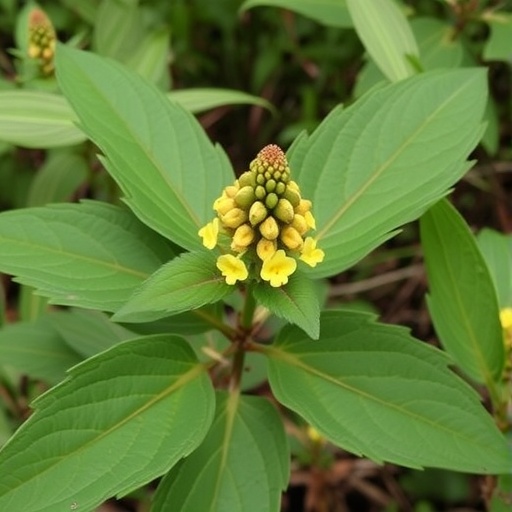In the heart of Southeastern Oromia, Ethiopia, a remarkable ecological stability is being threatened by the invasive species Senna didymobotrya, commonly known as the black-eyed Susan. This plant, originally from tropical regions, has rapidly adapted to various environmental conditions, offering an alarming insight into how invasive species can disrupt local ecosystems. Recent research by Osman and Telila has meticulously assessed the impacts of Senna didymobotrya on plant diversity, revealing key findings that underscore the urgency of addressing invasive species management in this region.
The study conducted by Osman and Telila provides a comprehensive evaluation of how Senna didymobotrya has proliferated in the Southeastern Oromia region. Researchers collected data from a variety of ecosystems within the area, observing the interactions between native plant species and the invasive Senna didymobotrya. What they found was particularly concerning: the invasive species exhibited a remarkable capacity to thrive in diverse habitats, often outcompeting local flora. This competition not only diminishes the native plant diversity but also destabilizes the ecological networks that depend on these plants for survival.
In their extensive analysis, the researchers employed both field observations and controlled experiments. They carefully documented the growth patterns of Senna didymobotrya, comparing its biomass to that of native species. The invasive plant demonstrated a striking ability to overshadow native vegetation, leading to significant reductions in native plants’ population densities. This shift in plant community structure could have cascading effects on higher trophic levels, including herbivores and predators that rely on these plants for food.
One of the most alarming consequences of the invasion by Senna didymobotrya is its potential to alter soil chemistry and nutrient cycling. The researchers noted that the presence of the invasive species was associated with declines in soil nutrients, particularly nitrogen and phosphorus, which are crucial for supporting diverse plant communities. As Senna didymobotrya establishes itself, it modifies the soil environment, creating conditions that further inhibit the growth of native plants. This phenomenon exemplifies the complex interplay between invasive species and ecosystem health, highlighting the need for informed management strategies.
Osman and Telila also explored the implications of Senna didymobotrya on local agricultural practices. As this invasive plant grows in abundance, it poses a serious threat to crop yields by competing for essential resources such as water, sunlight, and nutrients. Farmers in the region are likely to face challenges as their traditional practices become compromised due to the encroachment of this invasive species. The economic impacts of such invasions can be profound, affecting food security and livelihoods.
To address the growing crisis posed by Senna didymobotrya, the researchers recommend a range of management strategies. One of the most effective approaches involves the careful monitoring of its spread and the implementation of invasive species control protocols. Early detection and rapid response can significantly curtail its establishment in vulnerable ecosystems. Biological control methods may also offer a promising avenue for managing this invasive plant, potentially through the introduction of natural predators or pathogens.
Education and community involvement are critical components of any successful invasive species management plan. Osman and Telila emphasize the need to raise awareness among local populations about the threats posed by invasive species like Senna didymobotrya. Mobilizing communities to participate in monitoring and control efforts will not only empower them but also enhance the effectiveness of conservation initiatives in the region.
The findings of this research hold profound implications for conservation efforts beyond Southeastern Oromia. As global trade and climate change continue to facilitate the spread of invasive species, understanding their impacts on biodiversity becomes ever more critical. The lessons learned from the battle against Senna didymobotrya may serve as a valuable case study for addressing similar challenges worldwide, underscoring the need for collaborative approaches in ecological research and invasive species management.
The future of plant diversity in Southeastern Oromia hangs in the balance, caught in the struggle against Senna didymobotrya. Immediate action is necessary to establish mitigation strategies that can protect native species and restore ecological balance. Osman and Telila’s research serves as a call to arms for conservationists, policymakers, and communities alike to prioritize the management of invasive species and safeguard the biodiversity that sustains their ecosystems.
In conclusion, the assessment of Senna didymobotrya’s impact on plant diversity in Southeastern Oromia is a critical contribution to the field of ecological research. It not only highlights the detrimental effects of invasive species on local ecosystems but also calls for urgent action to reverse the tide of biodiversity loss. By embracing collaborative management strategies and fostering community engagement, it is possible to chart a path towards resilience in the face of ecological challenges. The battle against invasive species is not just local; it is a global imperative requiring concerted efforts and a commitment to preserving our natural heritage.
As we continue to grapple with the complexities of biological invasions, the research led by Osman and Telila stands as a vital reminder of the fragile nature of ecosystem dynamics. Their work not only informs our understanding of invasive species impacts but also inspires hope in our capacity to combat these ecological threats. Moving forward, it will be imperative to integrate scientific findings into practical conservation strategies, ensuring the longevity of biodiversity in our ever-changing world.
Subject of Research: The impacts and extent of the invasive species Senna didymobotrya on plant diversity in Southeastern Oromia, Ethiopia.
Article Title: Assessment of the impacts and extent of the invasive species Senna didymobotrya (Fresen.) H.S.Irwin & Barneby on plant diversity in a Southeastern Oromia, Ethiopia.
Article References:
Osman, M., Telila, H. Assessment of the impacts and extent of the invasive species Senna didymobotrya (Fresen.) H.S.Irwin & Barneby on plant diversity in a Southeastern Oromia, Ethiopia.
Discov. Plants 2, 295 (2025). https://doi.org/10.1007/s44372-025-00317-x
Image Credits: AI Generated
DOI:
Keywords: Invasive species, Senna didymobotrya, plant diversity, Southeastern Oromia, ecological impacts, biodiversity conservation, soil chemistry, agricultural threat, community involvement.




